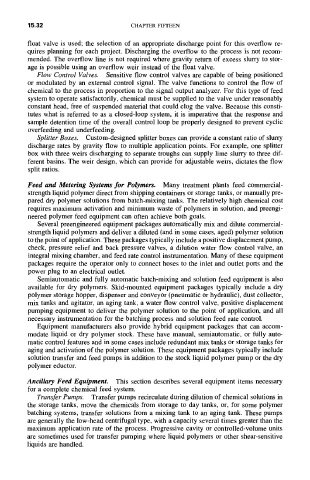Page 527 -
P. 527
1 ~.32 CHAPTER FIFTEEN
float valve is used; the selection of an appropriate discharge point for this overflow re-
quires planning for each project. Discharging the overflow to the process is not recom-
mended. The overflow line is not required where gravity return of excess slurry to stor-
age is possible using an overflow weir instead of the float valve.
Flow Control Valves. Sensitive flow control valves are capable of being positioned
or modulated by an external control signal. The valve functions to control the flow of
a
chemical to the process in proportion to ""~Ul~ bl~lldl ~'~--"1 uutt~ut ..........na.yLcL1 ..... For this type of feed
system to operate satisfactorily, chemical must be supplied to the valve under reasonably
constant head, free of suspended material that could clog the valve. Because this consti-
tutes what is referred to as a closed-loop system, it is imperative that the response and
sample detention time of the overall control loop be properly designed to prevent cyclic
overfeeding and underfeeding.
Splitter Boxes. Custom-designed splitter boxes can provide a constant ratio of slurry
discharge rates by gravity flow to multiple application points. For example, one splitter
box with three weirs discharging to separate troughs can supply lime slurry to three dif-
ferent basins. The weir design, which can provide for adjustable weirs, dictates the flow
split ratios.
Feed and Metering Systems for Polymers. Many treatment plants feed commercial-
strength liquid polymer direct from shipping containers or storage tanks, or manually pre-
pared dry polymer solutions from batch-mixing tanks. The relatively high chemical cost
requires maximum activation and minimum waste of polymers in solution, and preengi-
neered polymer feed equipment can often achieve both goals.
Several preengineered equipment packages automatically mix and dilute commercial-
strength liquid polymers and deliver a diluted (and in some cases, aged) polymer solution
to the point of application. These packages typically include a positive displacement pump,
check, pressure relief and back pressure valves, a dilution water flow control valve, an
integral mixing chamber, and feed rate control instrumentation. Many of these equipment
packages require the operator only to connect hoses to the inlet and outlet ports and the
power plug to an electrical outlet.
Semiautomatic and fully automatic batch-mixing and solution feed equipment is also
available for dry polymers. Skid-mounted equipment packages typically include a dry
polymer storage hopper, dispenser and conveyor (pneumatic or hydraulic), dust collector,
mix tanks and agitator, an aging tank, a water flow control valve, positive displacement
pumping equipment to deliver the polymer solution to the point of application, and all
necessary instrumentation for the batching process and solution feed rate control.
Equipment manufacturers also provide hybrid equipment packages that can accom-
modate liquid or dry polymer stock. These have manual, semiautomatic, or fully auto-
matic control features and in some cases include redundant mix tanks or storage tanks for
aging and activation of the polymer solution. These equipment packages typically include
solution transfer and feed pumps in addition to the stock liquid polymer pump or the dry
polymer eductor.
Ancillary Feed Equipment. This section describes several equipment items necessary
for a complete chemical feed system.
Transfer Pumps. Transfer pumps recirculate during dilution of chemical solutions in
the storage tanks, move the chemicals from storage to day tanks, or, for some polymer
batching systems, transfer solutions from a mixing tank to an aging tank. These pumps
are generally the low-head centrifugal type, with a capacity several times greater than the
maximum application rate of the process. Progressive cavity or controlled-volume units
are sometimes used for transfer pumping where liquid polymers or other shear-sensitive
liquids are handled.

